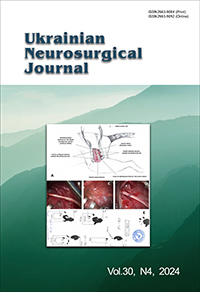Surgical treatment of meningiomas invading the superior sagittal sinus
DOI:
https://doi.org/10.25305/unj.312398Keywords:
meningioma, superior sagittal sinus, angiography, hemiparesisAbstract
Objective: To investigate the impact of the degree of invasion of the superior sagittal sinus by meningiomas on the radicality of removal and to assess the risks of complications during surgical intervention for superior sagittal sinus meningiomas.
Materials and Methods: The study included 82 patients who underwent surgery at the Romodanov Neurosurgery Institute over the past 10 years (from 2013 to 2023). The cohort comprised 53 women and 29 men, with an average age of 43.4±1.7 years. Inclusion criteria are: a histologically confirmed diagnosis of meningioma and evidence of superior sagittal sinus invasion based on neuroimaging (MRI with intravenous contrast enhancement, MSCT angiography).
Results: A total of 84 surgical procedures were performed on 82 patients. Among these, 71 were primary cases (84.5%), and 13 were secondary cases (15.5%). In 7 out of 13 secondary surgeries, superior sagittal sinus invasion was first detected through neuroimaging and confirmed intraoperatively. Postoperative hemiparesis of varying degrees was observed in 41 patients (50%), with 10 cases showing an increase in neurological deficits due to surgical intervention. Motor deficits completely regressed within 3-6 months post-surgery in 28 out of 41 patients. Tumor recurrence was identified in 4 patients (4.9%) within 2.5-6 years after the primary surgery. Among these, 3 were morphologically confirmed as "anaplastic meningioma Grade III," and 1 as "atypical meningioma Grade II".
Conclusions: Meningiomas originating from the arachnoid membrane constitute a significant proportion of primary intracranial tumors, with varying degrees of venous sinus invasion. Surgical planning for meningiomas invading the superior sagittal sinus should consider the radiological classification of invasion degrees, which aids in determining the treatment strategy. MRI with intravenous contrast and MSCT angiography are crucial for identifying collateral blood flow and assessing the degree of venous sinus invasion before surgical intervention.
References
1. Aghi M, Barker Ii FG. Benign adult brain tumors: an evidence-based medicine review. Prog Neurol Surg. 2006;19:80-96. [CrossRef] [PubMed]
2. Schmutzer M, Skrap B, Thorsteinsdottir J, Fürweger C, Muacevic A, Schichor C. Meningioma involving the superior sagittal sinus: long-term outcome after robotic radiosurgery in primary and recurrent situation. Front Oncol. 2023 Jul 11;13:1206059. [CrossRef] [PubMed] [PubMed Central]
3. Gatterbauer B, Gevsek S, Höftberger R, Lütgendorf-Caucig C, Ertl A, Mallouhi A, Kitz K, Knosp E, Frischer JM. Multimodal treatment of parasagittal meningiomas: a single-center experience. J Neurosurg. 2017 Dec;127(6):1249-1256. [CrossRef] [PubMed]
4. Gagliardi F, De Domenico P, Snider S, Pompeo E, Roncelli F, Barzaghi LR, Acerno S, Mortini P. Efficacy of radiotherapy and stereotactic radiosurgery as adjuvant or salvage treatment in atypical and anaplastic (WHO grade II and III) meningiomas: a systematic review and meta-analysis. Neurosurg Rev. 2023 Mar 17;46(1):71. [CrossRef] [PubMed]
5. Gravbrot N, Rock CB, Weil CR, Rock CB, Burt LM, DeCesaris CM, Jensen RL, Shrieve DC, Cannon DM. Gross Tumor and Intracranial Control Benefits with Fractionated Radiotherapy Compared with Stereotactic Radiosurgery for Patients with WHO Grade 2 Meningioma. World Neurosurg. 2024 Aug;188:e259-e266. [CrossRef] [PubMed]
6. Sindou MP, Alvernia JE. Results of attempted radical tumor removal and venous repair in 100 consecutive meningiomas involving the major dural sinuses. J Neurosurg. 2006 Oct;105(4):514-25. [CrossRef] [PubMed]
7. Simon M, Gousias K. Grading meningioma resections: the Simpson classification and beyond. Acta Neurochir (Wien). 2024 Jan 23;166(1):28. [CrossRef] [PubMed] [PubMed Central]
8. Fisher RS, van Emde Boas W, Blume W, Elger C, Genton P, Lee P, Engel J Jr. Epileptic seizures and epilepsy: definitions proposed by the International League Against Epilepsy (ILAE) and the International Bureau for Epilepsy (IBE). Epilepsia. 2005 Apr;46(4):470-2. [CrossRef] [PubMed]
9. Torp SH, Solheim O, Skjulsvik AJ. The WHO 2021 Classification of Central Nervous System tumours: a practical update on what neurosurgeons need to know-a minireview. Acta Neurochir (Wien). 2022 Sep;164(9):2453-2464. [CrossRef] [PubMed] [PubMed Central]
10. Lubgan D, Rutzner S, Lambrecht U, Rössler K, Buchfelder M, Eyüpoglu I, Fietkau R, Semrau S. Stereotactic radiotherapy as primary definitive or postoperative treatment of intracranial meningioma of WHO grade II and III leads to better disease control than stereotactic radiotherapy of recurrent meningioma. J Neurooncol. 2017 Sep;134(2):407-416. [CrossRef] [PubMed]
Downloads
Published
How to Cite
Issue
Section
License
Copyright (c) 2024 Mykhaylo S. Kvasha, Anatoliy V. Spiridonov

This work is licensed under a Creative Commons Attribution 4.0 International License.
Ukrainian Neurosurgical Journal abides by the CREATIVE COMMONS copyright rights and permissions for open access journals.
Authors, who are published in this Journal, agree to the following conditions:
1. The authors reserve the right to authorship of the work and pass the first publication right of this work to the Journal under the terms of Creative Commons Attribution License, which allows others to freely distribute the published research with the obligatory reference to the authors of the original work and the first publication of the work in this Journal.
2. The authors have the right to conclude separate supplement agreements that relate to non-exclusive work distribution in the form of which it has been published by the Journal (for example, to upload the work to the online storage of the Journal or publish it as part of a monograph), provided that the reference to the first publication of the work in this Journal is included.









